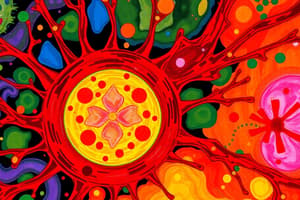Podcast
Questions and Answers
What is the primary consequence if a cell fails to adapt to stress?
What is the primary consequence if a cell fails to adapt to stress?
- The cell will experience cellular injury. (correct)
- The cell will undergo hyperplasia.
- The cell will maintain its normal function.
- The cell will stabilize through homeostasis.
Which of the following types of adaptation is characterized by an increase in cell size?
Which of the following types of adaptation is characterized by an increase in cell size?
- Metaplasia
- Hypertrophy (correct)
- Dysplasia
- Atrophy
Which type of cellular adaptation involves an increase in the number of cells?
Which type of cellular adaptation involves an increase in the number of cells?
- Atrophy
- Dysplasia
- Hyperplasia (correct)
- Metaplasia
What defines homeostasis in relation to cellular function?
What defines homeostasis in relation to cellular function?
Which of the following adaptations is not considered a minor type?
Which of the following adaptations is not considered a minor type?
Which of the following statements regarding cell adaption is false?
Which of the following statements regarding cell adaption is false?
What are the five minor types of adaption?
What are the five minor types of adaption?
Which factor does NOT contribute to cellular atrophy?
Which factor does NOT contribute to cellular atrophy?
What is an example of physiological atrophy?
What is an example of physiological atrophy?
Which of the following correctly explains the role of denervation in cellular atrophy?
Which of the following correctly explains the role of denervation in cellular atrophy?
List some common causes of atrophy (hint 6 in class)
List some common causes of atrophy (hint 6 in class)
What is the primary distinction between hypoplasia and atrophy?
What is the primary distinction between hypoplasia and atrophy?
Which of the following terms refers to incomplete or underdevelopment of an organ?
Which of the following terms refers to incomplete or underdevelopment of an organ?
A condition characterized by the complete lack of development of an organ is known as:
A condition characterized by the complete lack of development of an organ is known as:
What does the term "hypotrophy" or "abiotrophy" describe?
What does the term "hypotrophy" or "abiotrophy" describe?
What does hypertrophy refer to?
What does hypertrophy refer to?
Which of the following is NOT commonly associated with hypertrophy?
Which of the following is NOT commonly associated with hypertrophy?
Which of the following mechanisms contributes to hypertrophy?
Which of the following mechanisms contributes to hypertrophy?
Which of the following is a growth factor that plays a role in hypertrophy?
Which of the following is a growth factor that plays a role in hypertrophy?
What happens when cardiac hypertrophy reaches its limit and the muscle mass can no longer cope with the increased burden?
What happens when cardiac hypertrophy reaches its limit and the muscle mass can no longer cope with the increased burden?
In extreme cases of cardiac hypertrophy, what may ultimately occur?
In extreme cases of cardiac hypertrophy, what may ultimately occur?
What is hyperplasia?
What is hyperplasia?
Which of the following cell types are most likely to undergo hyperplasia?
Which of the following cell types are most likely to undergo hyperplasia?
What is an example of physiologic hyperplasia?
What is an example of physiologic hyperplasia?
Which statement about permanent cells is correct?
Which statement about permanent cells is correct?
What is a common cause of pathological hyperplasia?
What is a common cause of pathological hyperplasia?
What is the most common cause of pathological hyperplasia?
What is the most common cause of pathological hyperplasia?
Which of the following is not an example of pathological hyperplasia?
Which of the following is not an example of pathological hyperplasia?
What is metaplasia?
What is metaplasia?
Which of the following is not an example of metaplasia?
Which of the following is not an example of metaplasia?
What is a possible outcome of metaplasia if the cause is not removed?
What is a possible outcome of metaplasia if the cause is not removed?
What does dysplasia refer to?
What does dysplasia refer to?
Which type of cells are most often affected by metaplasia?
Which type of cells are most often affected by metaplasia?
Dysplasia can also be described as the alteration in its ___, ___, and ____, usually affecting the epithelium, occasionally associated with neoplastic transformation.
Dysplasia can also be described as the alteration in its ___, ___, and ____, usually affecting the epithelium, occasionally associated with neoplastic transformation.
Flashcards
Cell Adaptation
Cell Adaptation
Cells adjust to stressors to maintain viability and function. This is a reversible change, necessary for survival.
Atrophy
Atrophy
Decrease in cell size due to reduced workload, decreased nutrients, or hormonal stimulation. Think of a muscle shrinking from lack of use.
Hypertrophy
Hypertrophy
Increase in cell SIZE due to increased workload, stimulation, or hormonal factors. Think of a muscle growing from exercise.
Hyperplasia
Hyperplasia
Signup and view all the flashcards
Dysplasia
Dysplasia
Signup and view all the flashcards
What is Atrophy?
What is Atrophy?
Signup and view all the flashcards
What are the common causes of Atrophy?
What are the common causes of Atrophy?
Signup and view all the flashcards
What is Sedentary Atrophy?
What is Sedentary Atrophy?
Signup and view all the flashcards
How can steroid therapy affect the adrenal cortex?
How can steroid therapy affect the adrenal cortex?
Signup and view all the flashcards
What is a potential consequence of tumor growth on surrounding tissues?
What is a potential consequence of tumor growth on surrounding tissues?
Signup and view all the flashcards
Study Notes
Cell Adaptation
- Cell adaptation occurs when cellular homeostasis is disrupted by stress or disease.
- Cells adapt to stress; failure to adapt leads to cellular injury.
- Adaptation preserves cellular viability and function.
- Adaptation is not an irreversible change.
- Adaptation can be physiological or pathological.
Types of Cellular Adaptation
- Atrophy: Decreased cell size and/or number, along with decreased metabolic activity after normal growth has been reached. Cells are not dead. This is characterized by a decrease in protein synthesis and an increase in protein degradation.
- Causes: Decreased workload, denervation, reduced blood supply or oxygen, inadequate nutrition, loss of endocrine stimulation, and aging (senescence).
- Examples: Muscle disuse (e.g., limb in a cast), sedentary lifestyle, atrophy of the adrenal cortex due to reduced ACTH stimulation (steroid therapy), atrophy in tissues adjacent to tumors due to pressure and compromised blood supply, and physiological atrophy (e.g., non-lactating mammary gland, postpartum uterus).
- Hypertrophy: Increased cell size.
- Hyperplasia: Increased cell number.
- Dysplasia: Disordered cell growth and maturation.
- Metaplasia: Replacement of one cell type by another.
Homeostasis
- Homeostasis is the tendency toward stability in the normal state of an organism.
Studying That Suits You
Use AI to generate personalized quizzes and flashcards to suit your learning preferences.



